Glycosis - Study guides, Class notes & Summaries
Looking for the best study guides, study notes and summaries about Glycosis? On this page you'll find 78 study documents about Glycosis.
All 78 results
Sort by
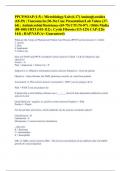
-
PPCP/SOAP (1-5) ; Microbiology/Lab (6-17) Aminoglycosides (18-29) ; Vancomycin (30-36) Case Presentation/Lab Values (37-64) ; Antimicrobial Resistance (65-75) UTI (76-87) ; Otitis Media (88-100) URTI (101-112) ; Cystis Fibrosis (113-125) CAP (126-144) ; H
- Exam (elaborations) • 18 pages • 2023
- Available in package deal
-
- $12.49
- + learn more
What are the 5 steps of Pharmacists' Patient Care Process (PPCP) correct answers 1. Collect 2. Assess 3. Plan 4. Implement 5. Follow-Up How are SOAP and PPCP correlated? correct answers Collect = S & O (subjective and objective) Assess = A Plan + Implement + Follow-Up = P Subjective vs. Objective information correct answers Subjective - from the patient Objective - from clinician, the EMR, pharmacy records, etc. (not from patient) Assessment vs. Plan correct answers Assessment...
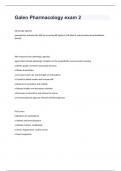
-
Galen Pharmacology exam 2 fully solved 2024/2025
- Exam (elaborations) • 54 pages • 2024
- Available in package deal
-
- $22.99
- + learn more
Galen Pharmacology exam 2Adrenergic Agonist epinephrine: activates the SNS by increasing BP (alpha1), HR (beta1) and promotes bronchodilation (beta2) SNS response from adrenergic agonists agents that activate adrenergic receptors in the sympathetic nervous system causing o Dilates pupils, increases intraocular pressure o Dilates bronchioles o Increases heart rate and strength of contractions o Constricts blood vessels and increases BP o Reduces GI secretions and motility o Relaxes...
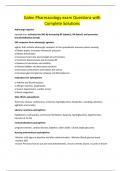
-
Galen Pharmacology exam Questions with Complete Solutions
- Exam (elaborations) • 30 pages • 2024
- Available in package deal
-
- $13.14
- + learn more
Adrenergic Agonist epinephrine: activates the SNS by increasing BP (alpha1), HR (beta1) and promotes bronchioldilation (beta2) SNS response from adrenergic agonists agents that activate adrenergic receptors in the sympathetic nervous system causing o Dilates pupils, increases intraocular pressure o Dilates bronchioles o Increases heart rate and strength of contractions o Constricts blood vessels and increases BP o Reduces GI secretions and motility o Relaxes bladder and decreases urina...
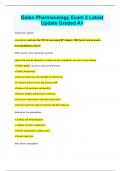
-
Galen Pharmacology Exam 2 Latest Update Graded A+
- Exam (elaborations) • 45 pages • 2024
- Available in package deal
-
- $11.99
- + learn more
Galen Pharmacology Exam 2 Latest Update Graded A+ Adrenergic Agonist epinephrine: activates the SNS by increasing BP (alpha1), HR (beta1) and promotes bronchioldilation (beta2) SNS response from adrenergic agonists agents that activate adrenergic receptors in the sympathetic nervous system causing o Dilates pupils, increases intraocular pressure o Dilates bronchioles o Increases heart rate and strength of contractions o Constricts blood vessels and increases BP o Reduces GI secret...
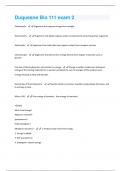
-
Duquesne Bio 111 exam 2 Updated Exam!!
- Exam (elaborations) • 6 pages • 2024
- Available in package deal
-
- $7.99
- + learn more
Phototrophs - Organisms that capture energy from sunlight Heterotrophs - Organisms that obtain organic carbon compounds by consuming other organisms Autotrophs - organisms that make their own organic carbon from inorganic sources Chemotrophs - Organisms that derive their energy directly from organic molecules such as glucose First law of thermodynamics and relation to energy - Energy is neither created nor destroyedenergy of the starting materials for a reaction will equal the sum of energi...
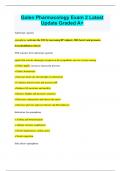
-
Galen Pharmacology Exam 2 Latest Update Graded A+
- Exam (elaborations) • 45 pages • 2024
-
- $11.99
- + learn more
Galen Pharmacology Exam 2 Latest Update Graded A+ Adrenergic Agonist epinephrine: activates the SNS by increasing BP (alpha1), HR (beta1) and promotes bronchioldilation (beta2) SNS response from adrenergic agonists agents that activate adrenergic receptors in the sympathetic nervous system causing o Dilates pupils, increases intraocular pressure o Dilates bronchioles o Increases heart rate and strength of contractions o Constricts blood vessels and increases BP o Reduces GI secretions...
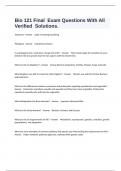
-
Bio 121 Final Exam Questions With All Verified Solutions.
- Exam (elaborations) • 8 pages • 2024
- Available in package deal
-
- $9.69
- + learn more
Taxonomy - Answer study of naming/classifying Phylogeny - Answer evolutionary history In a phylogenic tree, what does a longer line infer? - Answer That it took longer for evolution to occur between the two species than the two species with the shorter line. What are the six kingdoms? - Answer Archae Bacteria, Eubacteria, Protista, Plantae, Fungi, Animalia What kingdom was split to create the sixth kingdom? - Answer Monera was split into Archae Bacteria and Eubacteria ...
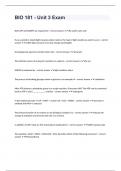
-
BIO 181 - Unit 3 Exam well answered to pass
- Exam (elaborations) • 5 pages • 2024
- Available in package deal
-
- $11.49
- + learn more
BIO 181 - Unit 3 ExamBoth ATP and NADPH are required for - correct answer the Calvin cycle only If you wanted to install lights to grow plants indoors, the type of light would you want to use is - correct answer visible light, because it has low energy wavelengths During glycosis, glucose is broken down into - correct answer pyruvate The ultimate source of energy for reactions in a plant is - correct answer the sun NADPH is produced by - correct answer light reactions alone The pr...
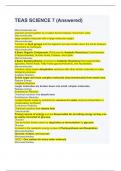
-
TEAS SCIENCE 7 (Answered)
- Exam (elaborations) • 9 pages • 2024
-
- $10.49
- + learn more
TEAS SCIENCE 7 (Answered) Macromolecules are polymers joined together by covalent bonds between monomeric units. Macromolecules large complex molecules with a large molecular weight. Macromolecules Function as food groups and the digestion process breaks down the bonds between monomers by hydrolysis. Macromolecules 4 Basic Organic Compounds: [Produced by Anabolic Reactions] Carbohydrates (Polysaccharides), Nucleic Acids, Proteins, and Lipids. Macromolecules 4 Basic Building Blocks:...
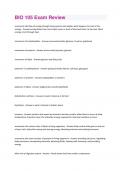
-
BIO 105 Exam Review Questions With All Correct Answers!!
- Exam (elaborations) • 11 pages • 2024
- Available in package deal
-
- $7.99
- + learn more
summarize the flow of energy through living systems and explain what happens to most of the energy. - Answer-energy flows from one trophic level, or level of the food chain, to the next. Most energy is lost through heat. monomers of carbohydrates - Answer-monosaccharides (glucose, fructose, galactose) monomers of proteins - Answer-amino acids (tyrosine, glycine) monomers of lipids - Answer-glycerol and fatty acids polymers of carbohydrates - Answer-polysaccharides (starch, cellulose, glyco...

How did he do that? By selling his study resources on Stuvia. Try it yourself! Discover all about earning on Stuvia


